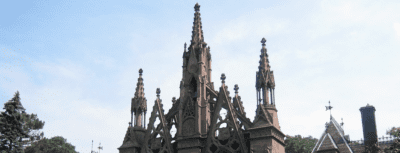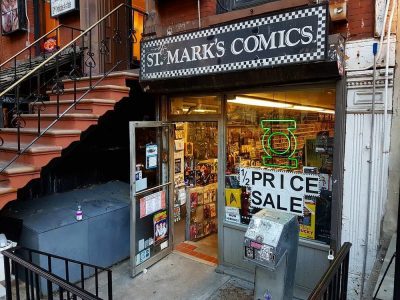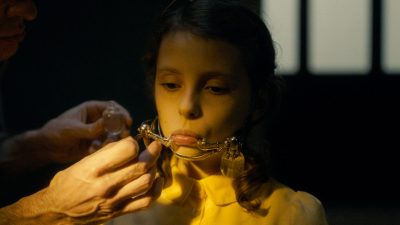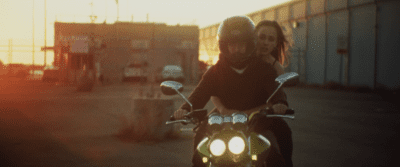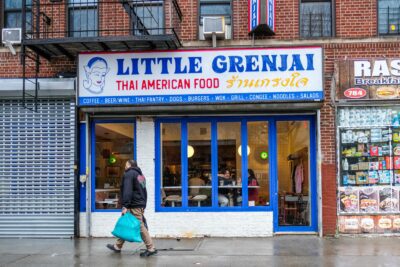'Kids in a tree, Maria Hernandez Park, Bushwick, Brooklyn' by Sebastian Anthony is licensed with CC BY-ND 2.0.
A love letter to Maria Hernandez Park
A microcosm of Brooklyn in two square Buskwick blocks, 32 years after the death of the its namesake—and not a little gentrification
In this era of corporate development, gentrification and beautification projects, Bushwick’s Maria Hernandez Park continues to exist somewhere between reality and fantasy. In spite of its compact layout, the park’s two-by-two block area is something of a Tardis of recreation—chock-a-block with a surprising variety of options for entertainment and amusement. Depending on the time of the day, it is Bushwick’s liveliest social club, marketplace, theater, discotheque, and sporting arena. More often than not, it is all of the above, all at once.
It wasn’t always like this. Thirty-two years ago August 8, the park’s namesake Maria Hernandez was murdered in front of her apartment, just outside the community space where she held block parties and events to organize against the prevalent drug and gang violence of Bushwick in the ‘80s. And before it went by Knickerbocker Park and Bushwick Park, it was a plot owned by several local landowners—one of whom was the circus impresario P.T. Barnum, who used the land as storage for his traveling menagerie.
Despite a constant stream of visitors and an endless calendar of community events today, a Google search of Maria Hernandez Park yields little outside of NYC Parks promos and news clippings of neighborhood overdoses. But to assign a platitude like “best kept secret” would be both cheap and untrue. For those who’ve ever lived in the neighborhood, the park is the spatial and spiritual center of Bushwick.
A recent visit to the park on a particularly muggy weekend afternoon found Dread and Rock sipping tall boys by the shaded outskirts of the park. The two friends, ged 23 years apart, met here six years ago, and like most visitors, are at Maria Hernandez this particular afternoon because … well, because why not? Their park hang today is, as usual, a happy accident. The two just bumped into each other. Rock, a 53-year-old Brownsville resident, makes the two-mile trip back to his former Bushwick stomping grounds every day.
“This is a relaxed place for me. I meet new people,” he says. “When I’m in the house and I’m bored, I can let loose and enjoy myself here.”
Dread, who’s 30 and lives in Flatbush, is also a regular here. He works in the area and stops by the park when around, which means he’s here five times a week. “It’s chill here,” he says. “You can be yourself. I don’t have to worry about anything. Where I’m from, I have to worry about a lot. Here, I don’t have to act tough. It’s like –” But before he can finish his thought, Rock interjects, “Nobody’s looking for danger. It’s all love. It’s family. When’s the last time you’ve seen a fight here?”
Some people remember the fights. Before the surrounding area became known for its thrift shops and vibrant murals, Bushwick was one of the city’s biggest victims of the urban blight spawned by failures in public policy. In the ‘70s, predatory lending and blockbusting in the housing market resulted in a meteoric rise in vacancy rates and arson cases. When the crack epidemic plagued the country in the ‘80s and ‘90s, it ravaged a sclerotic neighborhood that was already underserved and ignored by the city. Abandoned buildings in the neighborhood became crack dens and the gang violence born of drug abuse spilled indiscriminately into public spaces.
That was in the past, but it’s not ancient history. Peering towards the heart of Maria Hernandez, Rock points across the chaotic, but clearly peaceful expanse. The performance stage at the central courtyard is currently dominated by a DJ leading a crowd of polychromatic ravers. Off to the side, a scrum of skaters is sharing a pack of Marlboro Golds. By the pull-up bars a few feet away are shirtless men running through calisthenics routines. And on the blacktop field behind them, there’s a soccer game among middle-aged Hispanic men, who’ve amassed a crowd of around 30 spectators with lawn chairs and coolers. And zigzagging through them all are ball-chasing children and dog walkers with Airpods.
Watching over all of this from the perch of a nearby bench is Carlos, who’s lived a block away from the park for 27 years since he first immigrated from Guatemala. A few years ago, he was a fixture of the weekend soccer league until he blew out his knee. Despite being sidelined, he still comes every weekend, and he has complicated feelings about the park that’s been inextricably tied to his entire life in America.
“Over the last 10 years, there’s been more white people,” he says. Glancing towards the dwindling, but still lively Pride rave in the courtyard, he added, “It’s not a big problem for me, but I don’t like some of their behavior.”
It’s impossible to talk about Maria Hernandez Park in 2021 without acknowledging that the Brooklyn of 2021 is the byproduct of gentrification over the past few decades. An influx of predominantly white residents has meant displacement and over-policing of Black and brown residents, and the clashes that often come with sudden demographic transitions.
Looking around, it’s pretty easy to spot those who likely wouldn’t have frequented the park a mere decade ago: techies in company-branded graphic tees, 20-something-year-olds in boutique leather sneakers reading Howard Zinn, and this nosy Korean kid with funny glasses prodding locals for their thoughts on the park. Yet, nobody looks or feels out of place.
Nearby, there’s a man sitting by the steps of the performance stage with two children. His name is Steven, and you can tell just by how he says “born and raised” that he knows Bushwick like a country boy knows his mountain trails. Over the past 35 years, Steven has seen the physical structure of the park evolve with its inhabitants. His earliest memories at Maria Hernandez are of summers in the now-nonexistent pool and his adolescent years were spent shooting the shit on top of the baseball backstop until it was covered to prevent kids like him from climbing the structure.
Today, Steven’s with his two daughters, Kayla and Amy, who are visiting him from Florida. He still lives nearby, and they come to the park every time they’re staying with dad. Steven remembers when the park was a meaner, tougher place; he lived around the corner when Maria Hernandez was killed—shot inside her own home while blowdrying her hair before going to work—less than half a block away. Her husband, who had been shot twice in the previous three years by drug dealers, and stabbed only two weeks prior, found her on the floor of their bedroom.
But this was long before Kayla and Amy’s time. Their associations with the park mostly entail Dad buying them cocos from the ice cream carts and playing with their cousins. I ask Kayla what her favorite memory of Maria Hernandez Park is, and she responds that despite the fact that she “isn’t a people person” that she will always remember today. “Seeing the Pride stuff and watching everybody happy and dancing—I really loved that.”
Amy, who is leaning a rainbow flag over her shoulder, nods and agrees, “Me too.” Hearing this, Steven smiles and bellows, “Dad took them to do it up!”
You might also like 

















